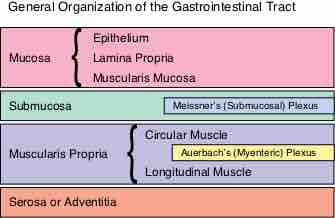The mucous membranes are linings of ectodermal origin. It consists of an epithelium layer and an underlying lamina propria of loose connective tissue. These mucus membranes are involved in absorption and secretion. They line cavities that are exposed to the external environment and internal organs. These membranes exist in the hollow organs of the digestive, respiratory, and urogenital tracts.
The term "mucous membrane" refers to where they are found in the body; not every mucous membrane secretes mucus. Secreted mucous traps the pathogens in the body, preventing any further progression of microbes.
Most mucous membranes contain stratified squamous or simple columnar epithelial tissue. The epithelial tissue sheet lies directly over the layer of loose connective tissue called lamina propria. In some mucosa, the lamina propria rests on a deeper, third layer of smooth muscle.
The submucosa is the tissue that connects the mucosa to the muscle outside the tube. Submucosal glands consist of exocrine glands that secrete mucus. These glands excrete mucus to facilitate the movement of particles along the body's various tubes, such as the throat and intestines. The submucosal glands are a companion to unicellular goblet cells, which also produce mucus, and are found lining the same tubes.

General organization of the gastrointestinial tract
Illustration of mucosa in relation to other lining components.